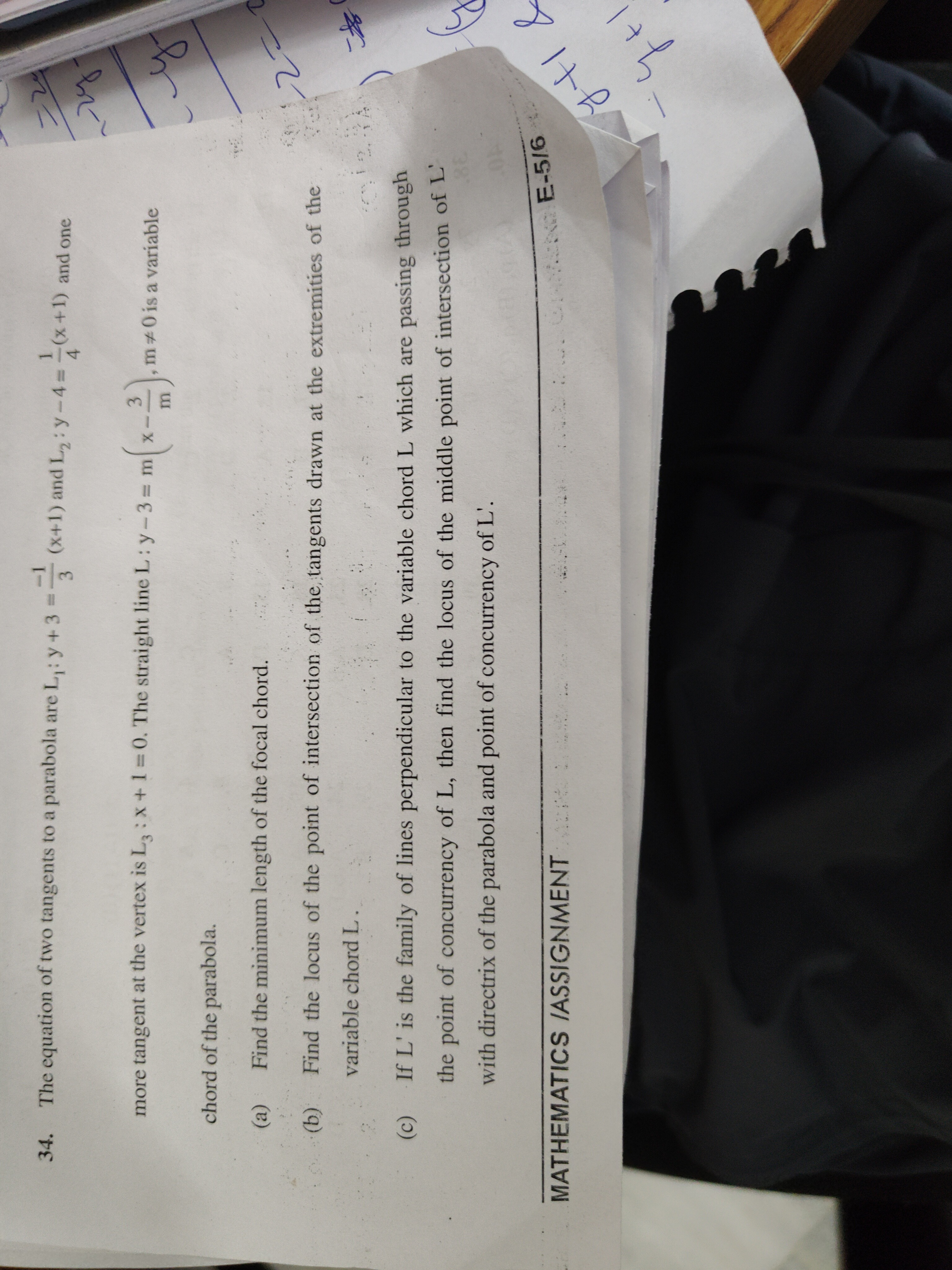Question
Question: 34. The equation of two tangents to a parabola are $L_1: y+3 = \frac{-1}{3}(x+1)$ and $L_2: y-4 = \f...
- The equation of two tangents to a parabola are L1:y+3=3−1(x+1) and L2:y−4=41(x+1) and one more tangent at the vertex is L3:x+1=0. The straight line L:y−3=m(x−m3), m=0 is a variable chord of the parabola.
(a) Find the minimum length of the focal chord.
(b) Find the locus of the point of intersection of the tangents drawn at the extremities of the variable chord L.
(c) If L' is the family of lines perpendicular to the variable chord L which are passing through the point of concurrency of L, then find the locus of the middle point of intersection of L' with directrix of the parabola and point of concurrency of L'.

a) 4, b) x=-1, y != 0, c) x=-1, y != 0
a) 2, b) y=-1, x != 0, c) y=-1, x != 0
a) 4, b) y=-1, x != 0, c) y=-1, x != 0
a) 2, b) x=-1, y != 0, c) x=-1, y != 0
a) 4, b) x=-1, y != 0, c) x=-1, y != 0
Solution
The problem requires finding the equation of a parabola given three tangents, and then solving three sub-problems related to focal chords, tangents, and loci.
1. Determining the Parabola's Equation The given tangents are: L1:y+3=3−1(x+1)⟹3y+9=−x−1⟹x+3y+10=0 L2:y−4=41(x+1)⟹4y−16=x+1⟹x−4y+17=0 L3:x+1=0
The tangent at the vertex is L3:x+1=0. This means the vertex lies on the line x=−1. Since the tangent at the vertex is vertical, the axis of the parabola is horizontal. Let the vertex be V(−1,k). The standard form of such a parabola is (y−k)2=4a(x+1) (assuming it opens to the right, which we will verify).
The equation of a tangent with slope m to the parabola (y−k)2=4a(x+1) is y−k=m(x+1)+ma. Rewriting this, y=mx+m+k+ma.
For L1, the slope is m1=−1/3. The equation is y=−31x−310. Comparing the constant term: −310=m1+k+m1a=−31+k+−1/3a=−31+k−3a. −39=k−3a⟹−3=k−3a⟹3a−k=3 (Equation 1).
For L2, the slope is m2=1/4. The equation is y=41x+417. Comparing the constant term: 417=m2+k+m2a=41+k+1/4a=41+k+4a. 416=k+4a⟹4=k+4a⟹4a+k=4 (Equation 2).
Solving the system of equations: (1) 3a−k=3 (2) 4a+k=4 Adding (1) and (2): 7a=7⟹a=1. Substituting a=1 into (1): 3(1)−k=3⟹k=0.
The vertex is V(−1,0) and a=1. The equation of the parabola is (y−0)2=4(1)(x+1)⟹y2=4(x+1). This parabola opens to the right. The focus F is at (h+a,k)=(−1+1,0)=(0,0). The directrix D is x=h−a=−1−1=−2.
Part (a): Minimum length of the focal chord. For a parabola y2=4ax, the length of a focal chord is 4acsc2θ, where θ is the angle the chord makes with the axis. The minimum length occurs when csc2θ=1 (i.e., θ=π/2), which corresponds to the latus rectum. Here, a=1, so the minimum length is 4(1)(1)=4.
Part (b): Locus of the point of intersection of the tangents drawn at the extremities of the variable chord L. The variable chord is L:y−3=m(x−m3). y−3=mx−3⟹y=mx. This chord passes through the origin (0,0), which is the focus of the parabola. Thus, L is a variable focal chord. Let P(h,k) be the point of intersection of the tangents. The chord of contact of tangents from P(h,k) to y2=4(x+1) is given by yk=2(x+h+1). This chord of contact is the line L:y=mx. So, yk=2x+2h+2. Rewriting this as y=k2x+k2(h+1). Comparing this with y=mx, we have: The slope: m=k2. The y-intercept must be zero: k2(h+1)=0. Since k=0 (because m=2/k is finite), we must have h+1=0⟹h=−1. The point of intersection P has coordinates (h,k)=(−1,k). Since m=0, k=2/m can be any non-zero real number. Therefore, the locus of P is the line x=−1, excluding the point where k=0, which is (−1,0) (the vertex).
Part (c): Locus of the middle point of intersection of L' with directrix of the parabola and point of concurrency of L'. L is the variable chord y=mx, passing through the focus F(0,0). So, the point of concurrency of L is F(0,0). L′ is the family of lines perpendicular to L and passing through F(0,0). The slope of L is m. The slope of L′ is −1/m. The equation of L′ is y−0=(−m1)(x−0)⟹y=−m1x. The directrix of the parabola is x=−2. Let Q be the point of intersection of L′ with the directrix. Substitute x=−2 into y=−m1x: y=(−m1)(−2)=m2. So, Q=(−2,m2). The point of concurrency of L′ is also the focus F(0,0) as all lines in L′ pass through it. Let M be the midpoint of the segment QF. M=(2−2+0,22/m+0)=(−1,m1). Let M=(xM,yM). Then xM=−1 and yM=1/m. Since m=0, yM=1/m can be any non-zero real number. Thus, the locus of M is the line xM=−1, with the condition yM=0. This is the line x=−1, excluding the point (−1,0).
The answers are: (a) Minimum length of the focal chord = 4. (b) Locus of the point of intersection of tangents = x=−1, y=0. (c) Locus of the midpoint = x=−1, y=0.
The combined answer is: a) 4, b) x=-1, y != 0, c) x=-1, y != 0.
